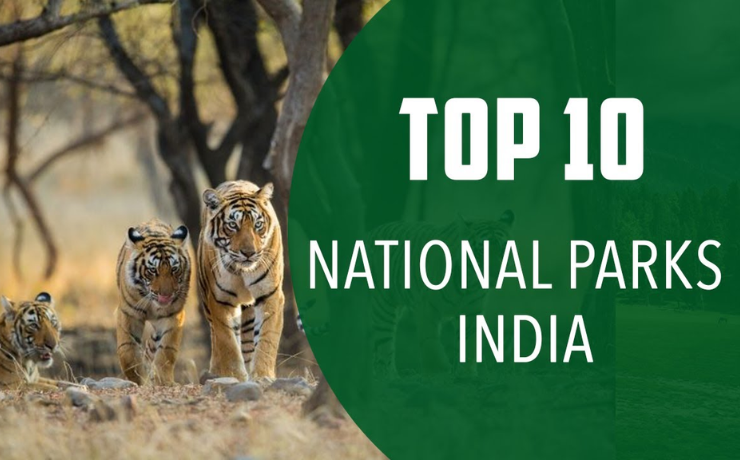Traveling in India is about finding new places, getting some fresh air, looking invisible and undoing. So why should leisure always be about mountainous towns? That should not be the case. The adventure spirit in you is worth visiting our wildest side of the versatile country, and it is better to explore the wonderful national parks in India. Here is a list of the top 5 national parks to be seen in India.
1. Ranthambore National Park, Rajasthan
Ranthambore is one of the top national parks to visit India. Ranthambore offers a wonderful blend of wildlife and history, Ranthambore Fort is in the Ranthambore National Park of Rajasthan. Rocky plains and muddy rocks characterize Ranthambore. Ranthambore Park is mainly famous due to its proximity to the national capital.
Ranthambore National Park is the largest and most famous national park in northern India. Ranthambore Tiger Reserve is present in Sawai Madhopur district of south-east Rajasthan, which is around 170 km from Jaipur international airport, Jaipur is the capital of the Rajasthan. Ranthambore National Park is considered one of the famous and former hunting grounds of the Maharajas of Jaipur. Today Ranthambore National Park is one of the prominent wildlife tourist attractions that attracted attention from many wildlife photographers and lovers in this destination.
Ranthambore is also known as the famous heritage site due to the paintings ruins on the wildlife park. Of course, the journey of Ranthambore National Park is a treat for every wildlife and nature lover. The time to spend on exploring the tigers that surround the national park, the evergreen greenery, bird’s tweet and other species of animals are invaluable and at least once valuable in life to explore.
Best time to visit in Ranthambore National park is October to -April.
2. Sariska National Park, Rajasthan
Sariska National Park is located in the Alwar district of Rajasthan state of India. In the topography of the protected area of Sariska National Park, scrub-spiny dry forests are rocky landscapes, dry deciduous forests, rocks, grasses, and mountainous rocks. This area was a hunting site of Alwar State, and it was declared a Wildlife Reserve by the Indian Government in 1955. Sariska was made a part of Project Tiger of India in 1978. Sariska Wildlife Sanctuary covers an area of 866 sq. Km. Sariska Forest Reserve was declared as the National Park of India in the year 1990. Sariska National Park has a total area of 273.8 square km. This park is the world’s first reserve to transfer tigers from Ranthambore National Park successfully.
The National Park is a deciduous forest with fields, lush scenery, and vertical nuisance. Sariska National Park encircles the ‘Lake Siliserhr’ and ‘Jai Samand Lake’, which is home to various crocodiles, water snakes and many living beings of Overland organisms and aquatic animals. Despite this fact, there are very few tourist sites around Sariska; National Park serves as an unexpected getaway for the visitors who are looking for peace of the diverse vegetation tourists.
Sariska Park is home to many carnivorous wild animals, including wild dogs, jungle cat, hyena, jackal, leopard, and tiger. The herbivorous animal species that are found in the park is Sambar, Nilgai, Chausingha, Chital, chinkara, and Langur.
3. Bandhavgarh National Park, Madhya Pradesh
Bandhavgarh National Park is one of the most popular National Parks of India, and it is located in the Umaria district of Madhya Pradesh. Bandhavgarh was declared a National Park in the area of 105 sq. Km in 1968. Buffer area in Bandhavgarh is spread over the forest departments of Umaria and Katni, and it is a total of 820 square kilometers. The name of the park is based on the region’s most prominent mountainous area, which Hindu Lord Ram gave to his brother Lakshman to keep a watch on Lanka (Ceylon).
There is a large biodiversity in this park. The density of tigers in Bandhavgarh is the most known in India. The park has a large breeding population of leopards, and there are various species of deer. In 1951, Maharaja Martand Singh of Rewa had caught the first white tiger in Bandhavgarh. This white tiger, Mohan, is now stuffed in the palace of the Rewa kings and is celebrating the splendor of the palace.
Bandhavgarh National Park is a park with an opulent mythological past in India. Former to becoming a national park of Bandhavgarh, forests around Bandhavgarh were retained for hunting sites or preserved for the game, Maharaja and their royal guests. Other attractions in Bandhavgarh National Park are wild boar, Indian Bison, Sambar, barking deer, langers and there are approximately 250 species of birds and many reptiles.
4. Kanha National Park, Madhya Pradesh
Kanha National Park is known for preserving many endangered species including bamboo woods, streams, and grasslands. In addition to the Tiger Safari in the Park, It is famous for its rainforest and many other birds and mammals.
Presently, the Kanha region is divided into two sanctuaries, Hallon and Banjar of 250 and 300 sq km respectively. Kanha National Park was declared on June 1, 1955, and in 1973 Kanha Tiger Reserve was come into existence. Today it is spread over 940 square km in Balaghat and Mandla in two districts. Kanha National Park has a buffer zone of 1067 sq km, and the area of 110 square kilometers of Phen Sanctuary is included in this, which makes Kanha a Tiger Reserve. Kanha Tiger Reserve is one of the top 10 famous places for tourists.
The park has a significant population of Royal Bengal tigers, Leopard, sloth bear, barasingha ( deer species) and Indian wild dog. It is also officially the first tiger reserves in India to present a mascot “Bhoorsingh-the Barasingha”.
5. Jim Corbett National Park, Uttarakhand
India’s trademark – Jim Corbett National Park is located in Uttarakhand. The name of this park was named after the world-famous Tiger hunter Jim Corbett. It was the first National Park in India in 1936.
Jim Corbett National Park has the distinction of being one of the oldest national parks in India. It was established in the form of Heli National Park to protect the dangerous Bengal tiger. Situated in the Nainital district of Uttarakhand, It was named after Jim Corbett who was a former Tiger hunter. He played an important role in the establishment of this park.
Jim Corbett National Park spread over an area of 1300 square kilometers, it is known for its majestic, striped tigers, wild elephants, sloth bears, Langurs, peacocks, and gharials. A total of 488 different wild animal species have been recorded in the park.
Top 5 National Parks In India










